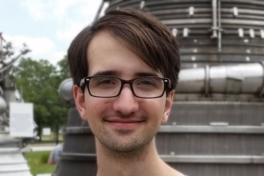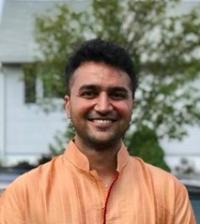Liz Vivas
This spring, three graduate students from the Department of Mathematics won outstanding research and teaching awards.
Benjamin Call has been awarded a Presidential Fellowship by the Ohio State Graduate School, Elizabeth Campolongo received a 2021 Graduate Associate Performance Award (GAPA) from the university's Graduate School and Dhir Patel received a 2021 Graduate Associate Teaching Award (GATA) from the university's Graduate School.
The Presidential Fellowship recognizes outstanding research done by a graduate student at the university level. The new GAPA Award acknowledges and recognizes the exceptional performance of graduate students while providing caregiving for children and others. The GATA Award is Ohio State’s highest recognition of exceptional teaching by graduate students serving as Graduate Teaching Associates.
The Department of Mathematics at Ohio State is extremely proud to have Benjamin, Elizabeth and Dhir as graduate students. To get to know them better, we are reproducing an interview with them here.
-
Describe your trajectory so far and how you arrived in the Department of Mathematics.

Benjamin Call (BC): I became interested in math in high school because I thought it would be a fun subject to teach. During college, I became interested in research as well, and I was lucky enough to be able to do some reading courses in dynamical systems with Amie Wilkinson, as well as some of her grad students, which led to my interest in dynamics overall. When I arrived at Ohio State, I started working with Dan Thompson as my advisor, which really helped influence how I think about and approach math.

Elizabeth Campolongo (EC): I have loved mathematics for as long as I can remember. Counting with my son and seeing his joy every time The Count appears on Sesame Street suggests one reason. Whatever the origins of my passion for math, my enthusiasm increases with each new area: Starting with cryptography as a kid, combining with algebra and number theory at NYU, and now focusing on harmonic analysis and geometric measure theory at Ohio State.

Dhir Patel (DP): My first research experience in mathematics was in senior year of my high school when I participated in the Hudson County Intel Science Fair Competition. I explained the mathematics involved in building a “star map” application for a smartphone which is used to identify planets, stars and other celestial bodies in the sky. I also had the opportunity to pursue research in pure mathematics during my undergraduate studies by attending a research program at the University of Hawaii-Hilo after my sophomore year and then another REU program at the University of Tennessee-Chattanooga. These experiences inspired me to pursue research in mathematics.
-
What is your advice for fellow graduate students who are balancing the same challenges that you are?
BC: I think that building a good support network is extremely important, whether it consists of some other grad students, your advisor, previous mentors or family and friends. Mine helped me get through my many rough patches throughout grad school, and I could always look to it when I needed advice.
EC: My advice (for anyone) is to find an advisor with a compatible work style because that relationship is key, especially when unexpected challenges arise. Specifically for parents: Stay engaged and busy, but be kind to yourself. Going for a long walk with your kid gives you both exercise and you time to let problems percolate.
DP: A lot of times there will be periods where one can feel that no progress is being made in their research/thesis problems. At times like these, obsessing over that research problem may do more harm than good. The thing that might help is having an outlet and finding a hobby that you enjoy fully: reading, gardening, exercising, exploring the city and such. Time away from the problem helps you think about a way around it because of the refreshed perspective when you return to it.
-
What is your favorite part of research and teaching?
BC: My favorite part of research is that moment when you finally understand why a result should be true (even if I still haven't gotten the proof to work yet). My favorite part of teaching is when students begin to glimpse the broader picture behind what they're learning (and hopefully are excited about it).
EC: I live for the “Aha!” moment, when it all comes together in a clear picture — for my research and my students. There is nothing more satisfying in research or teaching than that moment of understanding. It is especially fun when shared.
DP: My favorite part of researching is how it teaches us to deal with failures. While researching or solving a problem, one will fail more times than succeed. That is, one will often learn more ways of how to not solve a problem than to solve a problem. The research journey teaches us to use those failures and change one thing at a time to convert those failures into a success. My favorite part about teaching is the challenge of coming up with intuitive and creative ways to present esoteric mathematical ideas and make my students excited to explore them further. Through teaching I get to interact with students from different majors and varying levels of interest in math and through humor and funny analogies, I enjoy watching that “Aha!” moment where my students understand a new concept or see how the abstract math idea applies in day-to-day lives.
Congratulations Ben, Elizabeth and Dhir!
